Yamaha VZ225B, Z250B, LZ250B, VZ250B Manual

VZ225B
Z250B
LZ250B
VZ250B
OWNER’S MANUAL
U.S.A.Edition
LIT-18626-05-27
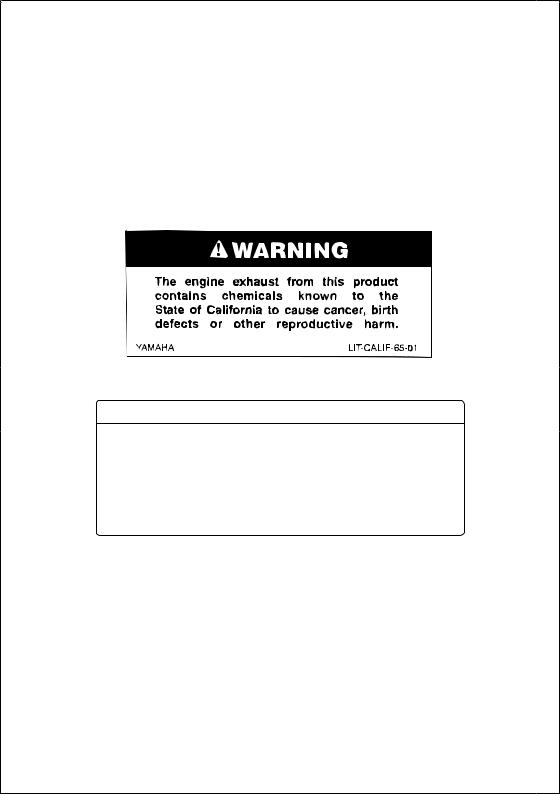
CAUTION
USE UNLEADED STRAIGHT GASOLINE ONLY
•Gasoline containing lead can cause performance loss and and engine damage.
•Do not use gasoline mixed with oil during the break-in period or any time afterwards.
YAMALUBE 2 STROKE OUTBOARD OIL IS RECOMMENDED
001629

E
EMU01449
TO THE OWNER
Thank you for choosing a Yamaha outboard motor. This Owner’s manual contains information needed for proper operation, maintenance and care. A thorough understanding of these simple instructions will help you obtain maximum enjoyment from your new Yamaha. If you have any question about the operation or maintenance of your outboard motor, please consult a Yamaha dealer.
In this Owner’s Manual particularly important information is distinguished in the following ways.
Q The Safety Alert Symbol means ATTENTION! BECOME ALERT! YOUR SAFETY IS INVOLVED!
w
Failure to follow WARNING instructions could result in severe injury or death to the machine operator, a bystander, or a person inspecting or repairing the outboard motor.
cC
A CAUTION indicates special precautions that must be taken to avoid damage to the outboard motor.
NOTE:
A NOTE provides key information to make procedures easier or clearer.
*Yamaha continually seeks advancements in product design and quality. Therefore, while this manual contains the most current product information available at the time of printing, there may be minor discrepancies between your machine and this manual. If there is any question concerning this manual, please consult your Yamaha dealer.
NOTE:
The Z250TR, LZ250TR, VZ250TR, and their standard accessories are used as a base for the explanations and illustrations in this manual. Therefore, some items may not apply to every model.
EMU01446
VZ225B, Z250B, LZ250B, VZ250B
OWNER'S MANUAL
©2002 by Yamaha Motor Corporation, USA 1st Edition, September 2002
All rights reserved.
Any reprinting or unauthorized use without the written permission of Yamaha Motor Corporation, USA is expressly prohibited.
Printed in Japan
P/N LIT-18626-05-27

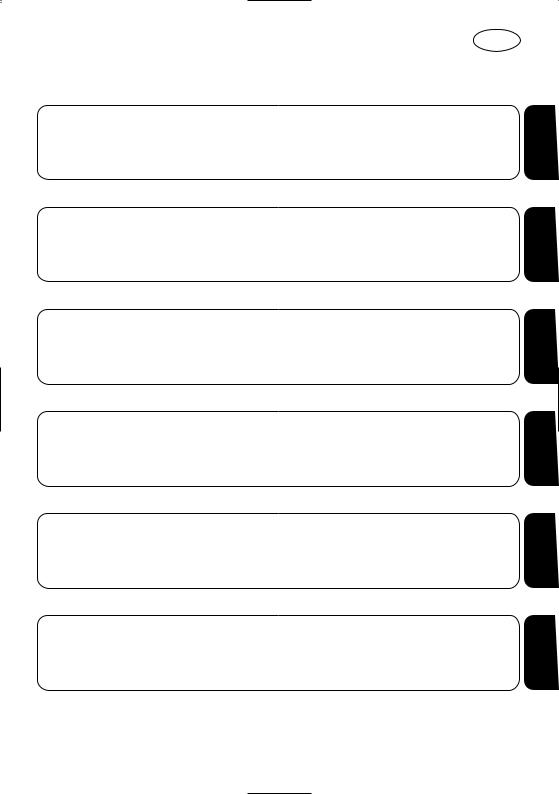
EMU00003
E
CONTENTS
GENERAL INFORMATION
BASIC COMPONENTS
OPERATION
MAINTENANCE
TROUBLE RECOVERY
INDEX
1
2
3
4
5
6
READ THIS OWNER’S MANUAL CAREFULLY BEFORE OPERATING YOUR OUTBOARD MOTOR.


E
EMU00004
Chapter 1 |
|
1 |
GENERAL |
|
|
|
|
|
INFORMATION |
|
|
IDENTIFICATION NUMBERS |
|
2 |
RECORD ................................................. |
1-1 |
|
Outboard motor serial number.............. |
1-1 |
|
Key number........................................... |
1-1 |
|
EMISSION CONTROL INFORMATION |
..1-2 |
|
North American models ........................ |
1-2 |
|
Star labels............................................. |
1-3 |
3 |
SAFETY INFORMATION ........................ |
1-4 |
|
IMPORTANT LABELS ............................ |
1-6 |
|
BASIC BOATING RULES ....................... |
1-8 |
|
FUELING INSTRUCTIONS................... |
1-12 |
4 |
Gasoline.............................................. |
1-13 |
|
Engine oil ............................................ |
1-13 |
|
BATTERY REQUIREMENT................... |
1-14 |
|
PROPELLER SELECTION ................... |
1-15 |
|
START-IN-GEAR PROTECTION........... |
1-16 |
5 |
6
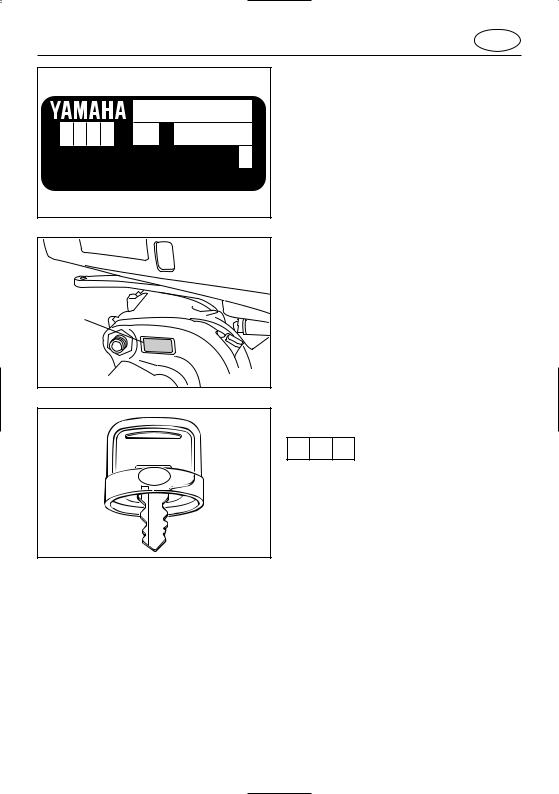
E
YAMAHA MOTOR CO., LTD. MADE IN JAPAN
PAYS D'ORIGINE JAPON
001383
q
001568
YAMAHA
q 123
123 
000319
EMU00005
IDENTIFICATION NUMBERS
RECORD
EMU00007
OUTBOARD MOTOR SERIAL NUMBER
The outboard motor serial number is stamped on the label attached to the port side of the clamp-bracket.
Record your outboard motor serial number in the spaces provided to assist you in ordering spare parts from your Yamaha dealer or for reference in case your outboard motor is stolen.
1 Outboard motor serial number
EMU00008
KEY NUMBER
If a main key switch is equipped with the motor, the key identification number is stamped on your key as shown in the illustration. Record this number in the space provided for reference in case you need a new key.
1 Key number
1-1
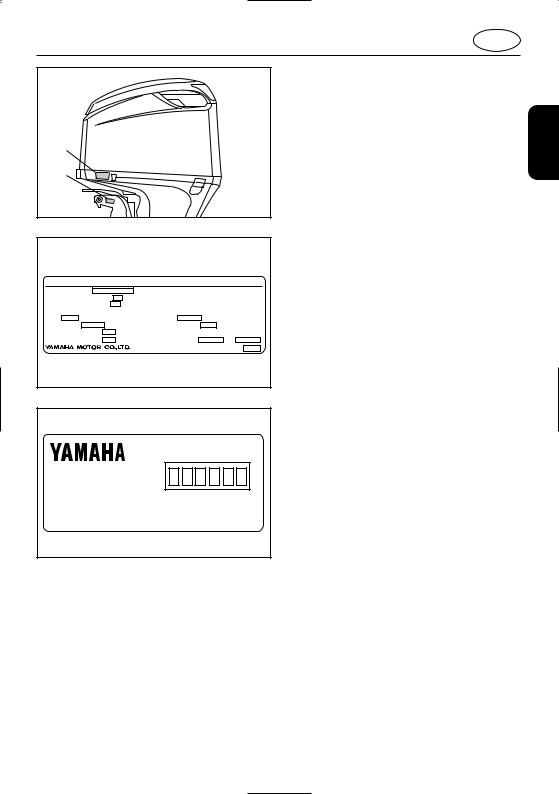
E
|
|
EMU01385 |
|
|
EMISSION CONTROL |
|
|
INFORMATION |
q |
|
EMU01902 |
w |
|
NORTH AMERICAN MODELS |
|
This engine conforms to U.S. Environmental |
|
|
|
|
|
|
Protection Agency (EPA) regulations for |
|
001592 |
marine SI engines. See the label affixed to |
|
|
|
|
|
your engine for details. |
q
EMISSION CONTROL INFORMATION |
DFI |
ENGINE FAMILY :
THIS ENGINE CONFORMS TO 2001 U.S. EPA REGULATIONS FOR MARINE SI ENGINES.
THIS ENGINE CONFORMS TO 2001 CALIFORNIA EMISSION REGULATIONS FOR SI MARINE ENGINES. REFER TO THE OWNERS MANUAL FOR MAINTENANCE SPECIFICATIONS AND ADJUSTMENTS.
FELs : |
g/kw-hr |
|
IDLE SPEED : |
rpm IN NEUTRAL |
SPARK PLUG : |
|
|
SPARK PLUG GAP (mm) : |
|
DISPLACEMENT : |
cm 3 |
FUEL : GASOLINE |
|
|
ADVERTISED POWER : |
kW |
VALVE LASH (mm) : IN |
EX |
|
Approval label of Emission control certificate
This label is attached to the bottom cowling.
1 Emission control information label
New Technology ; (4-stroke/HPDI) DFI
Manufactured date label
This label is attached to the clamp bracket.
w |
2 Manufactured date label |
|
|
Manufactured: |
|
1-2
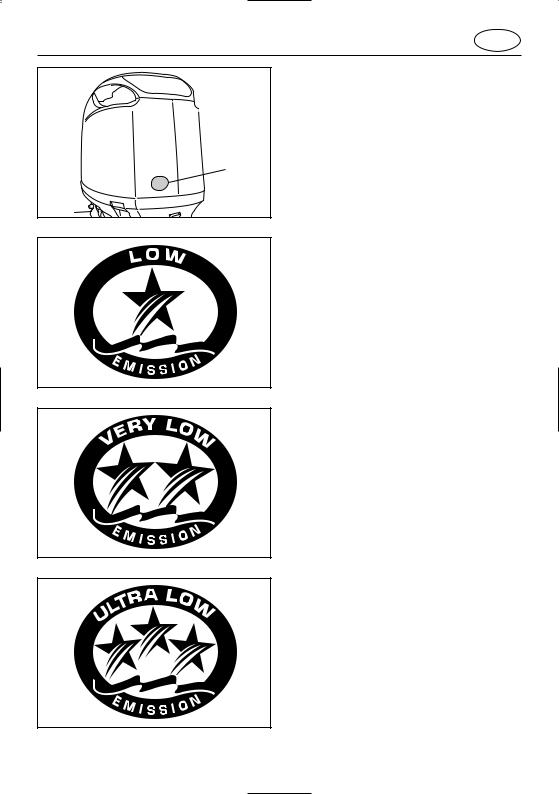
E
q
001569
EMU01389
STAR LABELS
Your outboard motor is labeled with a California Air Resources Board (CARB) star label. See below for a description of your particular label.
1 Star label
One Star - Low Emission
The one-star label identifies engines that meet the Air Resources Board’s 2001 exhaust emission standards. Engines meeting these standards have 75% lower emissions than conventional carbureted twostroke engines. These engines are equivalent to the U.S. EPA’s 2006 standards for marine engines.
Two Stars - Very Low Emission
The two-star label identifies engines that meet the Air Resources Board’s 2004 exhaust emission standards. Engines meeting these standards have 20% lower emissions than One Star-Low-Emission engines.
Three Stars - Ultra Low Emission
The three-star label identifies engines that meet the Air Resources Board’s 2008 exhaust emission standards. Engines meeting these standards have 65% lower emissions than One Star-Low-Emission engines.
1-3

E
EMU00917
QSAFETY INFORMATION
8Before mounting or operating the outboard motor, read this entire manual. Reading it should give you an understanding of the motor and its operation.
8Before operating the boat, read any owner’s or operator’s manuals supplied with it and all labels. Be sure you understand each item before operating.
8Do not overpower the boat with this outboard motor. Overpowering the boat could result in loss of control. The rated power of the outboard should be equal to or less than the rated horsepower capacity of the boat. If the rated horsepower capacity of the boat is unknown, consult the dealer or boat manufacturer.
8Do not modify the outboard. Modifications could make the motor unfit or unsafe to use.
8Never operate after drinking alcohol or taking drugs. About 50% of all boating fatalities involve intoxication.
8Have an approved personal flotation device (PFD) on board for every occupant. It is a good idea to wear a PFD whenever boating. At a minimum, children and non-swimmers should always wear PFDs, and everyone should wear PFDs when there are potentially hazardous boating conditions.
8Gasoline is highly flammable, and its vapors are flammable and explosive. Handle and store gasoline carefully. Make sure there are no gas fumes or leaking fuel before starting the engine.
8This product emits exhaust gases which contain carbon monoxide, a colorless, odorless gas which may cause brain damage or death when inhaled. Symptoms include nausea, dizziness, and drowsiness. Keep cockpit and cabin areas well ventilated. Avoid blocking exhaust outlets.
8Check throttle, shift, and steering for proper operation before starting the engine.
8Attach the engine stop switch lanyard to a secure place on your clothing, or your arm or leg while operating. If you accidentally leave the helm, the lanyard will pull from the switch, stopping the engine.
8Know the marine laws and regulations where you will be boating - and obey them. Refer to the “RULES OF THE ROAD” section for basic boating rules.
8Stay informed about the weather. Check weather forecasts before boating. Avoid boating in hazardous weather.
8Tell someone where you are going: leave a Float Plan with a responsible person. Be sure to cancel the Float Plan when you return.
1-4
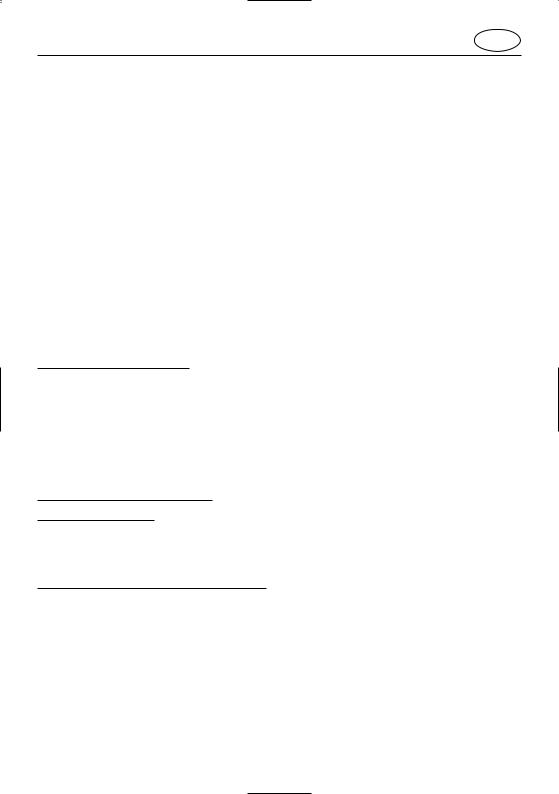
E
8Use common sense and good judgment when boating. Know your abilities, and be sure you understand how your boat handles under the different boating conditions you may encounter. Operate within your limits, and the limits of your boat. Always operate at safe speeds, and keep a careful watch for obstacles and other traffic.
8Always watch carefully for swimmers during the engine operation.
8Stay away from swimming areas.
8When a swimmer is in the water near you shift into neutral and shut off the engine.
8Be informed about boating safety. Additional publications and information can be obtained from many organizations, including the following:
United States Coast Guard
Consumer Affairs Staff (G-BC)
Office of Boating, Public, and Consumer
Affairs
U.S. Coast Guard Headquarters
Washington, D.C. 20593-0001
Boating Safety Hotline: 1-800-368-5647
National Marine Manufacturers
Association (NMMA)
401 N. Michigan Ave.
Chicago, Il 60611
Marine Retailers Association of America
155 N. Michigan Ave.
Chicago, Il 60601
1-5
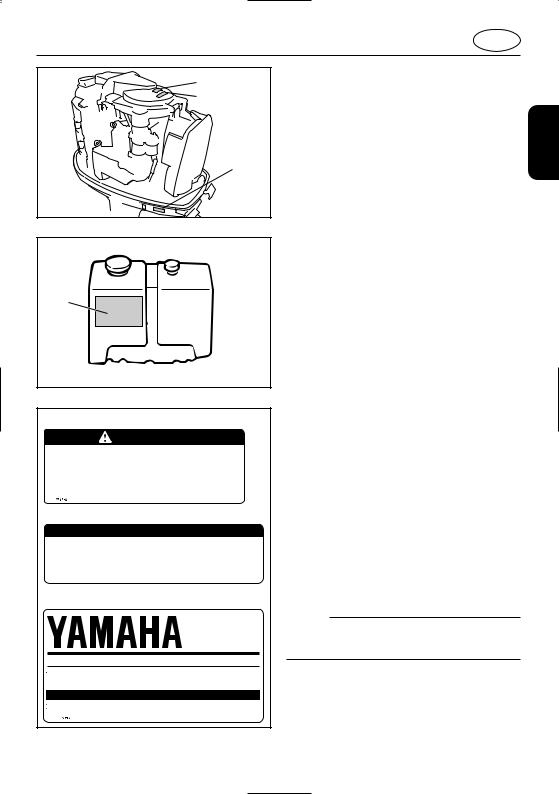
E
|
EMU00014* |
|
q |
IMPORTANT LABELS |
|
w |
||
|
r
001582
e
000577
1
WARNING
¡Be sure shift control is in neutral before starting engine. (except 2HP)
¡Do not touch or remove electrical parts when starting or during operation.
¡Keep hands,hair,and clothes away from flywheel and other rotating parts while engine is running.
6A1-83625-41
2 (LZ250)
 WARNING
WARNING
Use only a counterclockwise rotation propeller with this engine.
Counterclockwise propellers are marked with a letter "L" after the size indication.
The wrong type of propeller could cause the boat to go
in an unexpected direction, which could lead to an accident.
YAMAHA |
6K1-83623-41 |
3
OIL TANK
CAPACITY:10.5 LITERS 11.1 U.S. qt.
9.2 IMP. qt.
ENGINE OIL ONLY
Pour the engine oil into this oil tank, not gasoline.
RECOMMENDED OIL:
YAMALUBE 2 STROKE OUTBOARD OIL or an equivalent TC-W3 certified outborad oil.
 WARNING
WARNING
Do not add gasoline to the oil tank.
Fire or explosion could result.
WARNING LABELS
NOTE:
For engine oil specifications, see “Engine oil” in this chapter.
6E5-13437-43
1-6
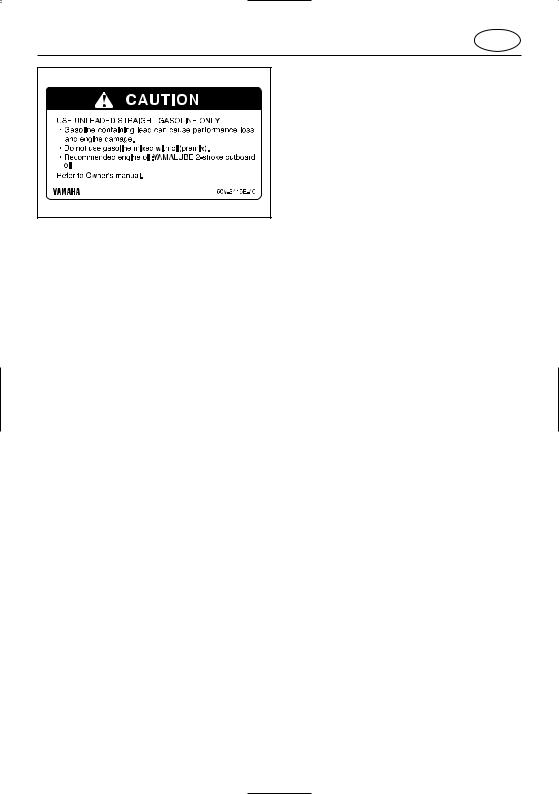
E
4 |
CAUTION LABELS |
|
1-7

E
EMU00015
BASIC BOATING RULES (Rules of the road)
Just as there are rules which apply when you are driving on streets and high ways, there are waterway rules which apply when you are driving your boat. These rules are used internationally, and are also enforced by the United States Coast Guard and local agencies. You should be aware of these rules, and follow them whenever you encounter another vessel on the water.
Several sets of rules prevail according to geographic location, but are all basically the same as the International Rules of the Road. The rules presented here in your Owner’s Manual are condensed, and have been provided for your convenience only. Consult your local U.S. Coast Guard Auxiliary or Department of Motor Vehicles for a complete set of rules governing the waters in which you will be using your boat.
STEERING AND SAILING RULES AND SOUND SIGNALS
Whenever two vessels on the water meet one another, one vessel has the right-of- way; it is called the “stand-on” vessel. The vessel which does not have the right-of-way is called the “give-way” or “burdened” vessel. These rules determine which vessel has the right-of-way, and what each vessel should do.
Stand-on vessel
The vessel with the right-of-way has the duty to continue its course and speed, except to avoid an immediate collision. When you maintain your direction and speed, the other vessel will be able to determine how best to avoid you.
Give-way vessel
The vessel which does not have the right- of-way has the duty to take positive and timely action to stay out of the way of the Stand-On vessel. Normally, you should not cross in front of the vessel with the right-of- way. You should slow down or change directions briefly and pass behind the other vessel. You should always move in such a way that the operator of the other vessel can see what you are doing.
“The general prudential rule”
This rule is called Rule 2 in the International Rules and says,
‘In obeying and construing these rules due regard shall be had to all dangers of navigation and collision, and to any special circumstances, which may render a departure from the above rules necessary in order to avoid immediate danger.’
In other words, follow the standard rules except when a collision will occur unless both vessels try to avoid each other. If that is the case, both vessels become “GiveWay” vessels.
1-8

E
RULES WHEN ENCOUNTERING VESSELS
There are three main situations which you may encounter with other vessels which could lead to a collision unless the Steering Rules are followed:
Meeting (you are approaching another vessel head-on)
Crossing (you are traveling across the other vessel’s path)
Overtaking (you are passing or being passed by another vessel)
In the following illustration, your boat is in the center. You should give the right-of-way to any vessels shown in white area (you are the Give-Way vessel). Any vessels in the shaded area must yield to you (they are the Give-Way vessels). Both you and the meeting vessel must alter course to avoid each other.
102045
Meeting
If you are meeting another power vessel head on, and are close enough to run the risk of collision, neither of you has the right- of-way! Both of you should alter course to avoid an accident. You should keep the other vessel on your port (left) side. This rule doesn’t apply if both of you will clear
one another if you continue on your set course and speed.
102044
Crossing
When two power driven vessels are crossing each other’s path close enough to run the risk of collision, the vessel which has the other on the starboard (right) side must keep out of the way of the other. If the other vessel is on your right, you must keep out of its way; you are the Give-Way vessel. If the other vessel is on your port (left) side, remember that you should maintain course and direction, provided the other vessel gives you the right-of-way as it should.
102046
Overtaking
If you are passing another vessel, you are the “Give-Way” vessel. This means that the other vessel is expected to maintain its course and speed. You must stay out of its
1-9

E
way until you are clear of it. Likewise, if another vessel is passing you, you should maintain your speed and direction so that the other vessel can steer itself around you.
OTHER SPECIAL SITUATIONS
There are three other rules you should be aware of when driving your boat around other vessels.
Narrow channels and bends
When navigating in narrow channels, you should keep to the right when it is safe and practical to do so. If the operator of a powerdriven vessel is preparing to go around a bend that may obstruct the view of other water vessels, the operator should sound a prolonged blast on the whistle (4 to 6 seconds). If another vessel is around the bend, it too should sound the whistle. Even if no reply is heard, however, the vessel should still proceed around the bend with caution. If you navigate such waters with your boat, you will need to carry a portable air horn, available from local marine supply stores.
Fishing vessel right-of-way
All vessels which are fishing with nets, lines or trawls are considered to be “fishing vessels” under the International Rules. Vessels with trolling lines are not considered fishing vessels. Fishing vessels have the right-of- way regardless of position. Fishing vessels cannot, however, impede the passage of other vessels in narrow channels.
Sailing vessel right-of-way
Sailing vessels should normally be given the right-of-way. The exceptions to this are:
1.When the sailing vessel is overtaking the power-driven vessel, the power-dri-
ven vessel has the right-of-way.
2.Sailing vessels should keep clear of any fishing vessel.
3.In a narrow channel, a sailing vessel should not hamper the safe passage of a power-driven vessel which can navigate only in such a channel.
Reading buoys and other markers
The waters of the United states are marked for safe navigation by the lateral system of buoyage. Simply put, buoys and markers have an arrangement of shapes, colors, numbers and lights to show which side of the buoy a boater should pass on when navigating in a particular direction. The markings on these buoys are oriented from the perspective of being entered from seaward (the boater is going towards the port). This means that red buoys are passed on the starboard (right) side when proceeding from open water into port, and black buoys are to port (left) side. When navigating out of port, your position with respect to the buoys should be reversed; red buoys should be to port and black buoys to starboard.
Many bodies of water used by boaters are entirely within the boundaries of a particular state. The Uniform State Waterway Marking System has been devised for these waters. This system uses buoys and signs with distinctive shapes and colors to show regulatory or advisory information. These markers are white with black letters and orange boarders. They signify speed zones, restricted areas, danger areas, and general information.
1-10
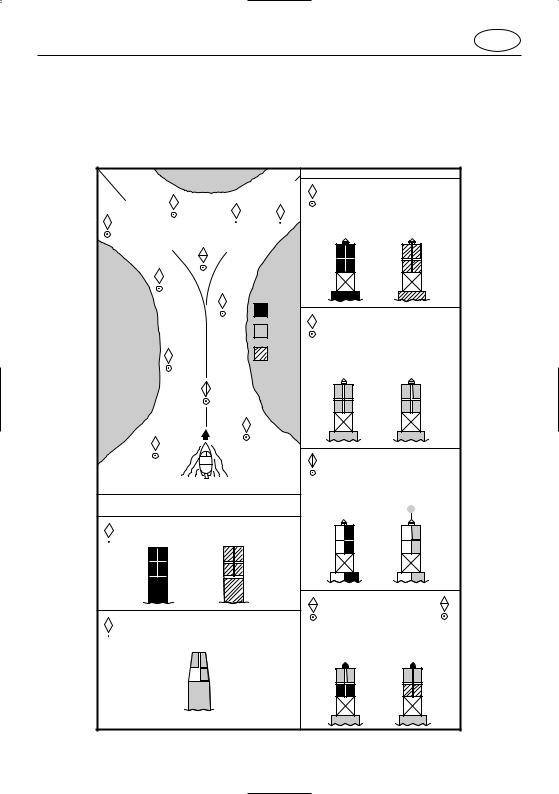
E
Remember, markings may vary by geographic location. Always consult local boating authorities before driving your boat in unfamiliar waters.
" 6"
" 7" |
MAIN |
|
CHANNEL |
||
|
||
|
" 5" |
" 3"
" 1"
RB " L" or
RG " L"
" A"
C " 1" |
CHANNEL |
" 2" |
|
SECONDARY |
|
|
BUOY |
" 4" |
COLOR CODE |
|
|
|
BLACK |
|
RED |
|
GREEN |
" 2"
Proceeding toward head of navigation from seaward
SECONDARY CHANNEL BUOYS
STARTS NEW NUMBERING SYSTEM
C " 1" |
CAN BUOY |
|
Odd number. Leave to port. |
1 |
1 |
|
OR |
old |
new |
N " 2" |
NUN BUOY |
|
|
|
Even number. Leave to starboard |
 2
2
No change
MAIN CHANNEL BUOYS
" 1" " 3" " 5" " 7"
LIGHTED BUOY (Port Hand)`
Odd number. increasing toward head of navigation.Leave to port (left) proceeding upstream.
White Light |
Green Light |
1 |
1 |
OR |
|
old |
new |
" 2" " 4" " 6"
LIGHTED BUOY (Starboard Hand)`
Even number,increasing toward head of navigation. Leave to starboard (right) proceeding upstream.
White Light |
Red Light |
2 |
2 |
OR |
|
old |
new |
" A"
LIGHTED SAFE WATER BUOY
No number. Marks midchannel, pass on either side. Letter has no lateral significance, used for identification and location purposes.
|
Top Mark |
White Light |
White Light |
AA
OR
old |
new |
RB " L" |
RG " L" |
LIGHTED PREFERRED CHANNEL TO
PORT BUOY
No number. Topmost band red - preferred channel is to left of buoy. Letter has no lateral significance, used for identification and location purposes.
Red or
Red Light
White Light
LL
old |
new |
102052
1-11
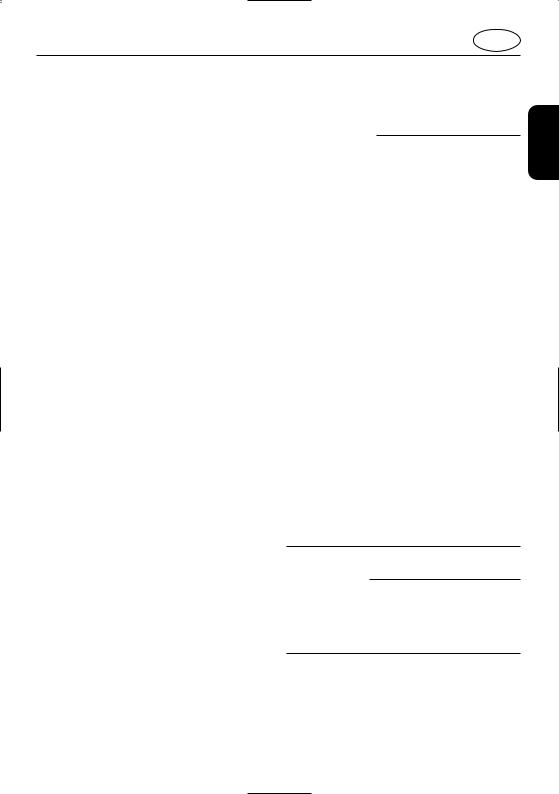
E
EMU01903
FUELING INSTRUCTIONS
w
GASOLINE AND ITS VAPORS ARE HIGHLY FLAMMABLE AND EXPLOSIVE!
8Do not smoke when refueling, and keep away from sparks, flames, or other sources of ignition.
8Stop engine before refueling.
8Refuel in a well-ventilated area. Refuel portable fuel tanks off the boat.
8Take care not to spill gasoline. If gasoline spills, wipe it up immediately with dry rags.
8Do not overfill the fuel tank.
8Tighten the filler cap securely after refueling.
8If you should swallow some gasoline, inhale a lot of gasoline vapor, or get gasoline in your eyes, get immediate medical attention.
8If any gasoline spills onto your skin, immediately wash with soap and water. Change clothing if gasoline spills on it.
8Touch the fuel nozzle to the filler opening or funnel to help prevent electrostatic sparks.
cC
Use only new clean gasoline which has been stored in clean containers and is not contaminated with water or foreign matter.
1-12
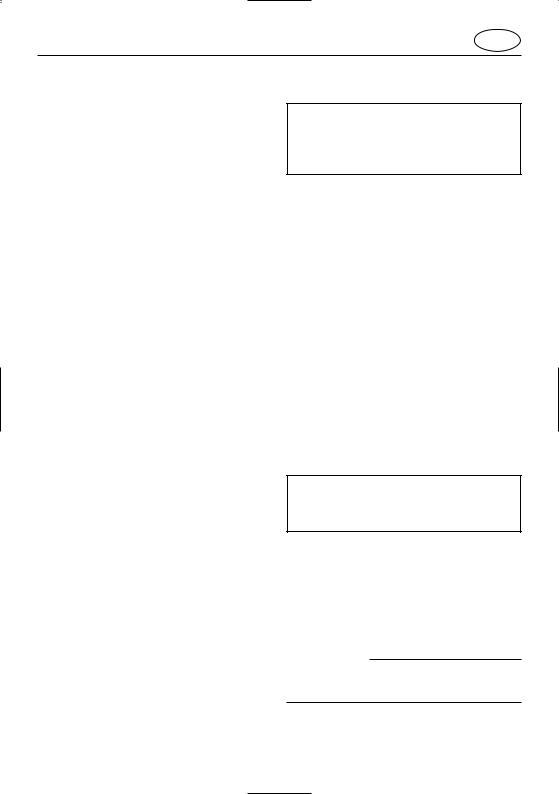
E
EMU01804
GASOLINE
Recommended gasoline:
Regular unleaded gasoline with a minimum octane rating of 86 (Pump Octane Number) = (R+M)/2
If knocking or pinging occurs, use a different brand of gasoline or premium unleaded fuel.
EMU00027
Gasohol
There are two types of gasohol: gasohol containing ethanol and that containing methanol. Gasohol containing ethanol can be used if ethanol content does not exceed 10% and the fuel meets minimum octane ratings. Gasohol containing methanol is not recommended by Yamaha because it can cause fuel system damage or engine performance problems.
EMU01911
ENGINE OIL
Recommended engine oil: YAMALUBE 2 STROKE OUTBOARD OIL
Yamalube 2 stroke outboard oil is strongly recommended for your Yamaha outboard motor. If Yamalube 2 stroke outboard oil is not available, a 2 stroke NMMAcertified TC-W3 oil of equivalent quality must be used.
cC
Serious damage could result from use of a lesser quality oil.
1-13
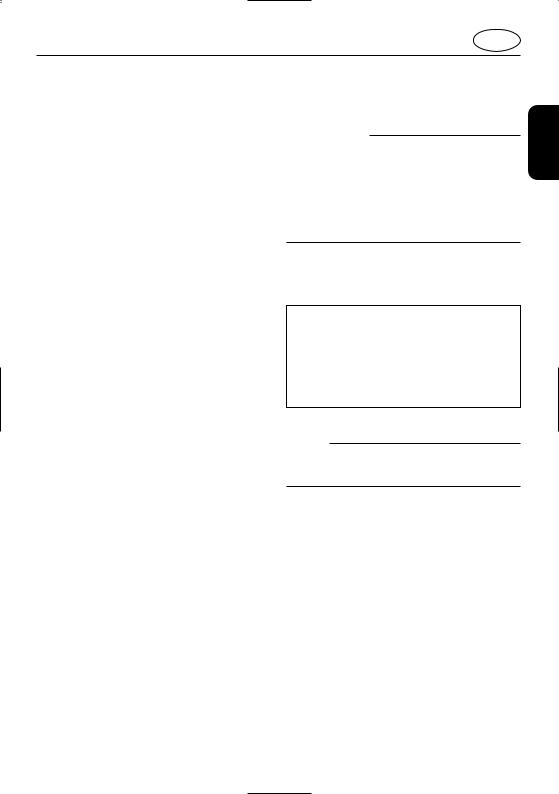
E
EMU01775
BATTERY REQUIREMENT
cC
Do not use a battery that does not meet the specified capacity. If a battery which does not meet specifications is used, the electric system could perform poorly or be overloaded, causing electric system damage.
For electric start models, choose a battery which meets the following specifications.
EMU01861
Minimum cold cranking amps (CCA/SAE): 512 amps at -18°C (-0.4°F) Minimum marine cranking amps (MCA/ABYC): 675 amps at 0°C (32°F) Minimum reserve capacity (RC/SAE):
182 minutes
EMU01787
NOTE:
The engine cannot be started if battery voltage is too low.
1-14
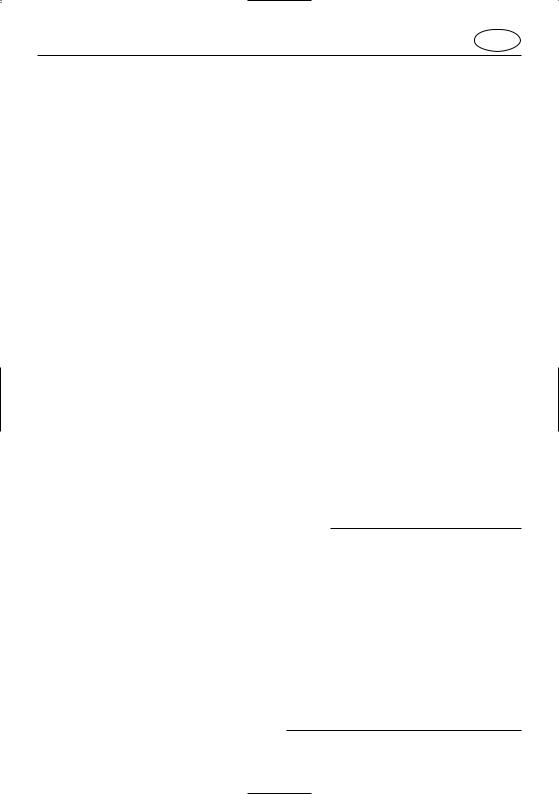
E
EMU01395
PROPELLER SELECTION
The performance of your outboard motor will be critically affected by your choice of propeller, as an incorrect choice could adversely affect performance and could also seriously damage the motor. Engine speed depends on the propeller size and boat load. If engine speed is too high or too low for good engine performance, this will have an adverse effect on the engine.
Yamaha outboard motors are fitted with propellers chosen to perform well over a range of applications, but there may be uses where a propeller with a different pitch would be more appropriate. For a greater operating load, a smaller-pitch propeller is more suitable as it enables the correct engine speed to be maintained. Conversely, a larger-pitch propeller is more suitable for a smaller operating load.
Yamaha dealers stock a range of propellers, and can advise you and install a propeller on your outboard that is best suited to your application.
NOTE:
At full throttle and under a maximum boat load, the engine’s rpm should be within the upper half of the full throttle operating range, as listed in “SPECIFICATIONS” on page 4-1. Select a propeller which fulfills this requirement.
If operating under conditions which allow the engine’s rpm to rise above the maximum recommended range (such as light boat loads), reduce the throttle setting to maintain the rpm in the proper operating range.
1-15

E
14-1/2 x 17 - M
qw e
602022
1 Propeller diameter (in inches)
2 Propeller pitch (in inches)
3 Type of propeller (propeller mark)
Refer to the section “CHECKING PROPELLER” for instructions on propeller removal and installation.
EMU01209
START-IN-GEAR PROTECTION
Yamaha outboard motors or Yamaha approved remote control units are equipped with start-in-gear protection device(s). This feature permits the engine to be started only when it is Neutral. Always select Neutral before starting the engine.
1-16

E
-MEMO-
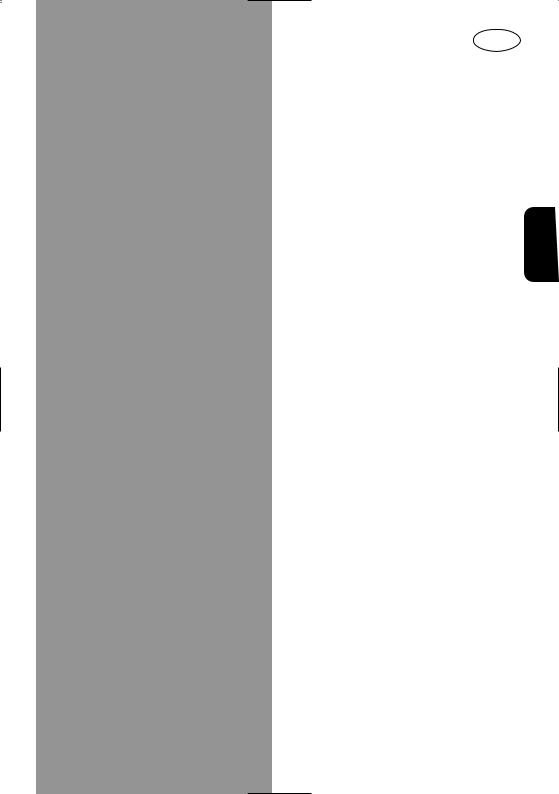
E
EMU00037
Chapter 2 |
|
|
BASIC COMPONENTS 1 |
||
MAIN COMPONENTS............................. |
2-1 |
|
OPERATIONS OF CONTROLS AND |
|
2 |
OTHER FUNCTIONS .............................. |
2-3 |
|
Remote control ..................................... |
2-3 |
|
Trim tab ................................................. |
2-9 |
|
Power trim/tilt switch ........................... |
2-10 |
|
Digital tachometer............................... |
2-11 |
3 |
Digital speedometer............................ |
2-13 |
|
Fuel management meter..................... |
2-16 |
|
Tilt support lever ................................. |
2-21 |
|
Top cowling lock levers ....................... |
2-21 |
|
Flushing device................................... |
2-21 |
|
WARNING SYSTEM ............................. |
2-22 |
|
Overheat warning ............................... |
2-22 |
4 |
Oil level warning and oil filter |
|
|
clogging warning................................. |
2-23 |
|
Water separator warning .................... |
2-24 |
|
5
6
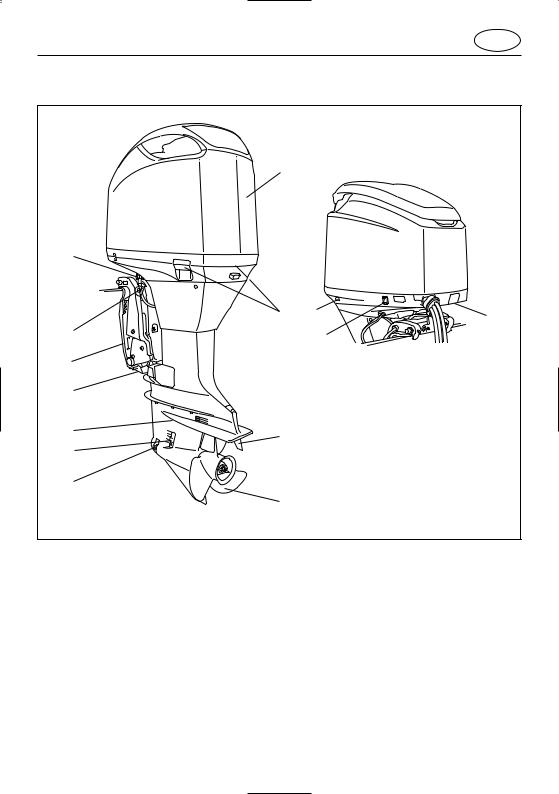
E
EMU01206
MAIN COMPONENTS
q
!1 |
|
|
|
|
w |
!3 |
w |
|
|
|
|
!0 |
|
!2 |
|
|
|
|
|
o |
|
|
|
i |
|
|
|
u |
e |
|
|
y |
|
|
|
t |
|
|
|
|
r |
|
|
1 Top cowling
2 Cowling lock levers
3 Trim tab (anode)
4 Propeller
5 Cooling water inlet (VZ225, VZ250)
6 Cooling water inlet (Z250, LZ250)
7 Anti-cavitation plate
8 Anode
9 Clamp bracket
0 Tilt support lever q Flushing device
w Power trim and tilt switch e Cooling water pilot hole
*May not be exactly as shown; also may not be included as standard equipment on all models.
2-1
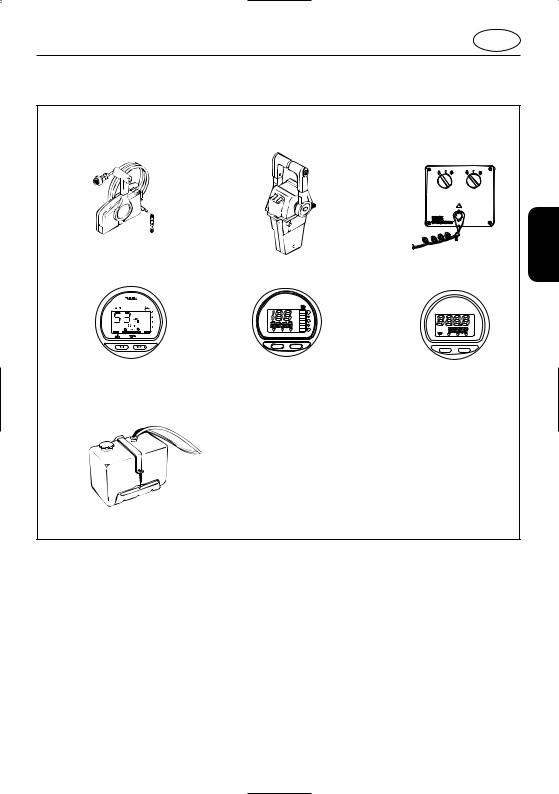
E
EMU01206
MAIN COMPONENTS
q |
w |
e |
r |
t |
|
y |
|
|
|
|
||
|
|
YAMAHA |
YAMAHA |
|
|
SPEED |
|
||
|
FUEL MANAGEMENT |
|||
|
|
Km/h |
||
|
|
knot |
|
|
|
|
mph |
|
I/h |
|
|
|
|
|
|
|
km |
|
gph |
|
|
mile |
P S |
mpg |
|
|
|
|
Km/L |
|
TRIP |
TIME BATT |
|
|
|
|
|
TTL ECON |
SYNC |
set mode
set mode
u
*1 Remote control box (side mount type) *2 Remote control box (binnacle mount type) *3 Switch panel (for use with 2)
*4 Digital tachometer *5 Digital speedometer
*6 Fuel management meter *7 Remote oil tank
*May not be exactly as shown; also may not be included as standard equipment on all models.
2-2
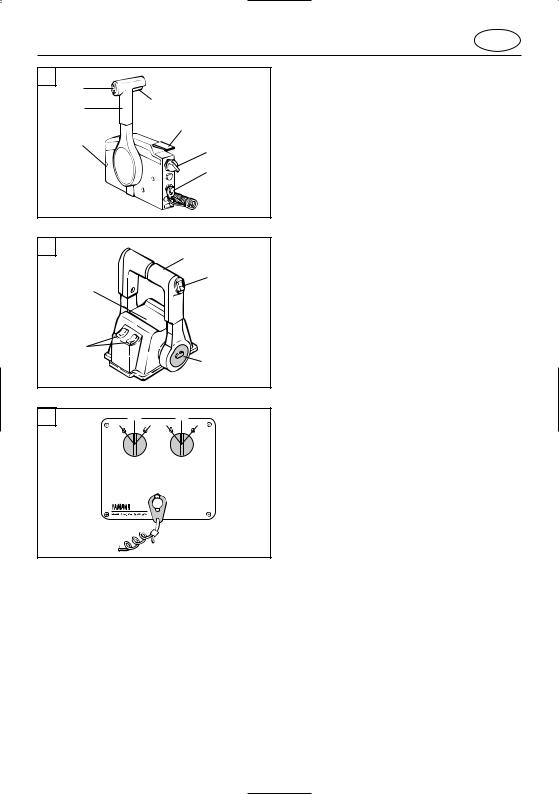
E
A u
qw
|
e |
i |
t |
|
|
|
y |
000322
B |
q |
|
u
i
u
|
|
r |
|
|
001276 |
C |
ON |
ON |
OFF START OFF |
START |
t y
y
EMU00039
OPERATIONS OF CONTROLS
AND
OTHER FUNCTIONS
EMU01273
REMOTE CONTROL
Both the shifter and the throttle are actuated by the remote control lever. In addition, the electrical switches are mounted on the remote control box.
å Side mount remote control box
∫ Binnacle mount remote control box ç Switch panel (for use with ∫)
1 Remote control lever
2 Neutral interlock trigger
3 Neutral throttle lever
4 Free accelerator
5 Main switch
6 Engine stop lanyard switch
7 Power trim/tilt switch
8 Throttle friction adjusting screw
001277
2-3
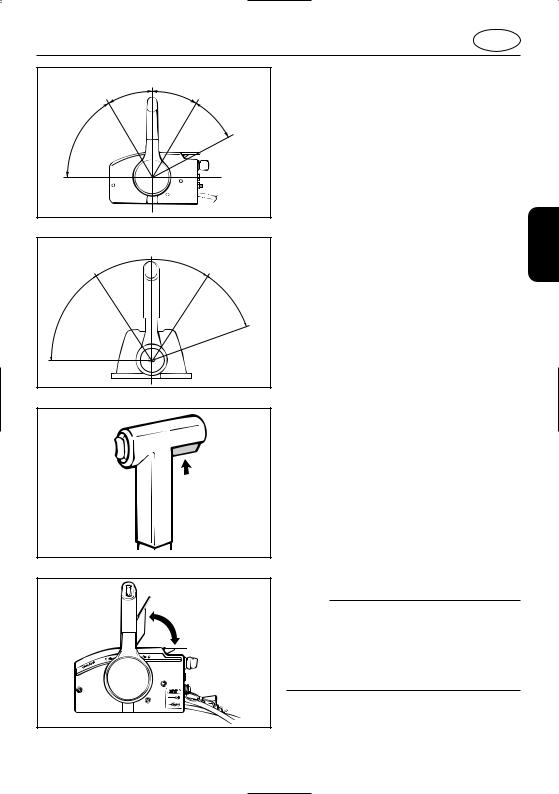
E
w |
|
r |
N q r |
e |
|
F |
|
|
|
R |
|
|
|
t |
t |
y |
|
y |
|
u |
|||
|
|
|
|
|
|
u |
|
|
|
|
|
|
|
|
|
|
701031 |
w |
|
r |
q |
r |
e |
|
|
|
|
||
y |
|
t |
|
t |
y |
|
|
|
|||
|
|
|
|
|
u |
u |
|
|
|
|
|
|
|
|
|
|
702032 |
|
|
UP |
|
|
|
|
|
DN |
|
|
|
|
|
|
|
|
000323 |
|
N |
q |
|
||
|
|
|
|
||
|
|
|
|
w |
|
|
|
|
|
|
000324 |
EMU00098
Remote Control Lever
Moving the lever forward from the Neutral position engages Forward gear. Pulling the lever back from Neutral engages Reverse. The engine will continue to run at idle until the lever is moved about 35° (a detent can be felt). Moving the lever farther opens the throttle, and the engine will begin to accelerate.
1 Neutral
2 Forward
3 Reverse
4 Shift
5 Fully closed
6 Throttle
7 Fully open
EMU00099
Neutral Interlock Trigger
To shift out of Neutral, the neutral interlock trigger of the remote control lever must first be pulled up.
EMU00100
Neutral Throttle Lever
To open the throttle without shifting into either Forward or Reverse, place the remote control lever in the Neutral position and lift the neutral throttle lever.
NOTE:
The neutral throttle lever will operate only when the remote control lever is in Neutral. The remote control lever will operate only when the neutral throttle lever is in the closed position.
1 Fully open
2 Fully closed
2-4
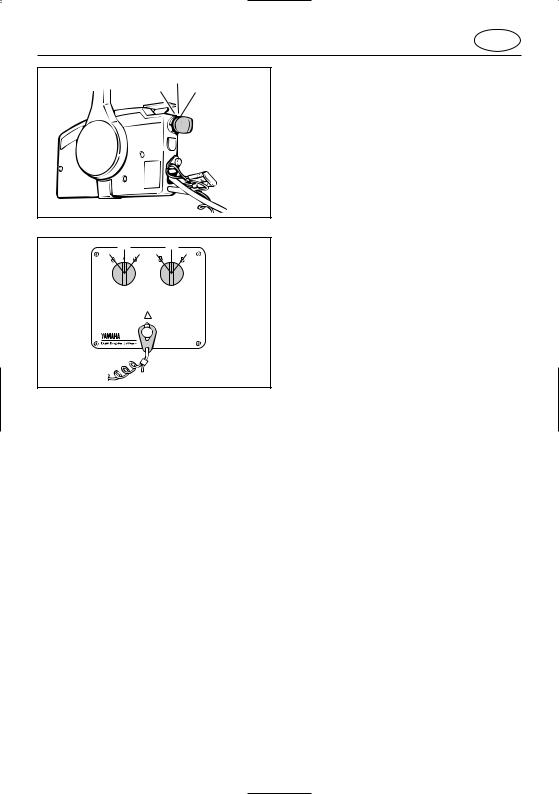
E
OFFON START
701021
ON |
ON |
OFF START OFF |
START |
EMU00101
Main switch
The main switch controls the ignition system; its operation is described below.
8OFF
Electrical circuits switched off. (The key can be removed.)
8ON
Electrical circuits switched on. (The key cannot be removed.)
8START
Starter-motor will turn and start engine. (When the key is released, it returns automatically to “ON”.)
001242
2-5
